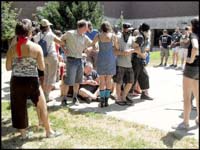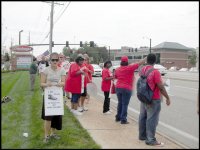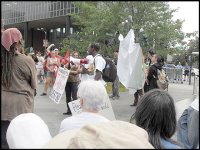
Midwest Rising Convergence activists train for a series of direct action protests in St. Louis against Monsanto and other corporate giants. Roughly 200 activists gathered at the University of Missouri-St. Louis, which also included workshops and panel discussions. [Photograph by Linda Greene
Billed as an anticorporate gathering of activists with a focus on environmental and economic justice and on the interconnectedness of social justice issues, the convergence was highlighted by several instances of direct action.
The convergence, which was an offshoot of last year’s U.S. Social Forum in Detroit, which drew about 15,000 participants, was a demographic miniature of the forum. Most of the high-spirited participants were young and white, with a smattering of middle-aged and elderly people, African Americans, Latinos and Latinas, Asian Americans and disabled people.
The workshops—some in small groups and others with the whole group—and panel discussions were geared toward preparing for the direct action.
Friday began with a whole-group workshop on facilitating meetings and decision making by consensus. After lunch there were exercises aimed at getting to know each other better as activists. Then several school buses transported the whole group to the Bank of America’s St. Louis headquarters for direct action.
* * *
The purpose of the Bank of America demonstration was to protest the bank’s policies and support five people who intended to close their accounts to protest those policies.
The largest bank in the nation, Bank of America was a good target. It has been foreclosing on hundreds of families without following proper procedures, is sitting on billions of dollars that could be reinvested in communities to rebuild cities and neighborhoods, charges some of the highest fees of any U.S. bank and profits from predatory loans. The bank paid no taxes in 2010 and receives subsidies and tax breaks that contribute to budget deficits and cuts in human services.
The activists were met by a barricade of sawhorses, a phalanx of private security guards and St. Louis’s SWAT team. After some lively chanting, the five account closers attempted to enter the bank’s lobby to close their accounts and get their money back, but the security guards refused to let them in. Bank officials stalled until the bank’s closing time, when a message came from bank officials to close the accounts on line. This message neglected to acknowledge the fact that not everyone has access to a computer and that one can’t receive a refund on line as one can in person.
The five people argued with the security workers as the crowd chanted, “Let them in!” “It’s their money!” The bank prevented the five account holders from canceling their accounts, but the universal feeling in the group was that the protest was effective in communicating people’s objections to the bank’s policies.
* * *

Convergence participants marched in solidarity with Verizon workers, who in August staged the nation’s largest strike in years. [Photograph by Linda Greene
Much of Sunday was devoted to preparing for Monday’s direct actions—four small events in the morning and a major one, involving civil disobedience, in the afternoon. People prepared for all the eventualities, including the worst: Tasers, tear gas and police dogs.
Sunday evening offered some hands-on activities, going door to door and using a phone bank to mobilize people for the major direct action on Monday.
* * *
On Monday morning the participants split up into groups for four Monday actions—at a Verizon store, the St. Louis board of education, Arch Coal and Monsanto.
According to union leaders, Verizon’s demands consist of outsourcing jobs overseas, gutting pension security, eliminating benefits for workers injured on the job, eliminating job security, slashing paid sick leave and raising health care costs. Verizon demanded its employees accept $1 billion in cuts to their pay and benefits (nearly $20 thousand per family), according to Worker Justice E-News on Aug. 15.
The company’s top five executives received $258 million in pay over the last four years. Since the beginning of this year, the unions claim, Verizon has earned $6 billion in profits.
Two labor unions, Communications Workers of America (CWA) and the International Brotherhood of Electrical Workers (IBEW), led a strike of 45,000 Verizon workers at the telecommunication giant’s eastern seaboard offices.
This strike was the largest one in the country in four years.
Convergence participants gathered outside a Verizon store in suburban St. Louis along with CWA and IBEW workers. In all, there were about 75 demonstrators energetically marching, chanting and waving picket signs in support of the striking workers.
* * *
Another group of convergence participants demonstrated at the St. Louis school board in an action organized by Missourians Organized for Reform and Empowerment.
The protestors’ grievances were several. The school board has cut funding for public schools, including librarians and parent support specialists. A flier handed out to passersby said, “Corporations and CEOs are pocketing billions in tax breaks while our schools are suffering. When you invest in education you invest in our future and our city. We demand that tax breaks to corporations that divert money from our schools end!”
The activists went to the school board to speak with decision makers and then gathered for a march at noon at a park in front of city hall. The activists drew the connection between corporate profits and school funding: the flier said, “We will demand that corporations, like Peabody Coal, give back tax breaks that are diverting funds away from our schools.”

Bank of America was another target of the Midwest Rising direct action. [Photograph by Linda Greene
From the 1950s to the 1970s, Westinghouse contaminated the Bloomington area with Inerteen, Monsanto’s brand of PCBs. Despite having been “cleaned up,” according to the EPA, PCBs still escape into the environment from toxic dumps in Bloomington.
PCBs, one of the most omnipresent contaminants on earth, are linked to a wide variety of health conditions, including skin and brain cancer, and developmental disabilities in children.
* * *
The fourth action took place at Arch Coal, one of the largest coal companies in the country. Coal mining, processing and burning are the largest sources of CO2, the primary greenhouse gas responsible for global climate change.
The major direct action of the convergence took place on Monday afternoon. It began with a march from a park to an intersection in downtown St. Louis that has Bank of America and Peabody Coal’s headquarters located on opposite sides of the street. When the 200 convergence participants reached the intersection, 14 people sat down, linked arms and blocked traffic. One by one the police carried them off to jail as the crowd chanted “Shame! Shame!”
A small group of youths unveiled an ingenious cardboard model of a coal plant that they turned inside out to form a school to demonstrate that coal companies and other corporations are receiving tax breaks with money that could be used for public schools.
The convergence participants met for the last time at a Monday afternoon debriefing. Everyone was tired but stimulated as they left for home to share with their fellow activists the exciting story of what they learned and achieved at the Midwest Rising Convergence.
Linda Greene can be reached at lgreene@bloomington.in.us.


